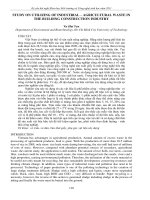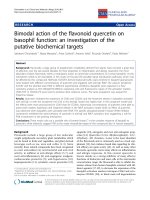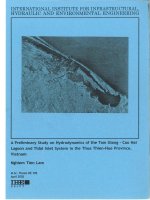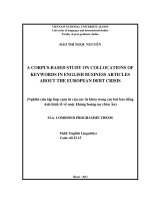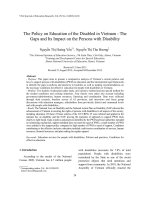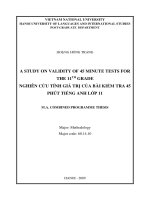Study on inspection of the putative hybrids between track lacking wild male gaur (Bos gaurus) and domestic female cow (Bos taurus) in Phuoc Binh national park, Vietnam
Bạn đang xem bản rút gọn của tài liệu. Xem và tải ngay bản đầy đủ của tài liệu tại đây (1.12 MB, 8 trang )
Journal of Biotechnology 15(4): 633-640, 2017
STUDY ON INSPECTION OF THE PUTATIVE HYBRIDS BETWEEN TRACK-LACKING
WILD MALE GAUR (BOS GAURUS) AND DOMESTIC FEMALE COW (BOS TAURUS)
IN PHUOC BINH NATIONAL PARK, VIETNAM
Le Hoang Duc1, 2, Pham Thanh Tung1, 2, Nguyen Trung Nam1, 2, Chu Hoang Ha1, 2, Le Xuan Tham3, Le
Van Son1, 2, *
1
Institute of Biotechnology, Vietnam Academy of Science and Technology
Graduate University of Science and Technology, Vietnam Academy of Science and Technology
3
Lam Dong Department of Science and Technology, Lam Dong, Vietnam
2
*
To whom correspondence should be addressed. E-mail:
Received: 23.11.2017
Accepted: 28.12.2017
SUMMARY
Hybridization between wild and domestic bovine occurs widely due to the overlapping of the natural
habitat of the wild and human farm animals. Due to the loss of habitat, the number of wild gaur (Bos gaurus) in
Vietnam was in serious decline. Since 2009, a male wild gaur (Bos gaurus) has appeared and incorporated with
female domestic cows (Bos taurus) in buffer zone Phuoc Binh National Park, on the border with Lam Dong
and Ninh Thuan provinces. Then, several calves were born that carried some traits of wild gaur including
physical characteristics and behaviors. These calves were supposed to be offspring between wild gaur and
domestic cows. In previous study, the karyotypes of putative calves were identified with 2n = 58 and nonhomologous chromosome 28 and 29 in these hybrids. In this study, we characterized the putative hybrids
between track-lacking Bos gaurus and Bos taurus for breeding and preservation using Cytochrome b analysis,
microsatellites and a novel marker growth hormone factor 1 (POU1F1). Cytochrome b analysis indicated the
maternal lineage of the putative hybrids, with 100% nucleotide sequence identity. Microsatellite BM861 and
sequence of ZFY gene region reveal Bos taurus chromosome Y origin was among the male putative hybrids.
Importantly, the analysis of POU1F1 gene sequence on 1 chromosome showed efficacy in determining both
Bos gaurus and Bos taurus lineage in the putative hybrids. The karyotyping results were confirmed by
molecular analysis and our results provide a feasible way for detecting the putative hybrids between wild and
domestic cattle in case of lacking the wild trace.
Keywords: Interspecific hybrids, molecular makers, paternal lineage, maternal lineage
INTRODUCTION
beefalo, a cross of bison (Bison bison) and taurine
cattle.
Interspecific hybridization happens to two
closely related species that share an overlapping
habitat or via human interference during captive
inbreeding. However, they also run a high risk of
being sterilized and fertility is often restricted to the
homogametic (Forsdyke, 2000). This can be
overcome by continuously backcrossing the hybrids
with either father or mother. Hence, the hybrids of
closely related species can be valuable in farming as
a way to improve quality of local domestic cattle.
For instance, yakows, a cross of yak (Bos grunniens)
and taurine cattle (Felius, 1995); selembu, a cross of
wild gaur (Bos gaurus) and zebu or the American
In Vietnam, the population of wild gaur (Bos
gaurus) is poorly investigated and they are believed
to decline in number due to loss of habitat. Since
2009, there has been observed that a lone male gaur
migrated to the buffer zone of Phuoc Binh National
Park and joined the local cattle herd for months and
left without trace. After that, there appeared a
number of newborn calves that carried unusual traits
compared to other ordinary domestic cattle in
consideration of physical characteristics and
behaviors. These calves were putative to be hybrids
between the lone male gaur (Bos taurus) and the
local domestic cows (Bos taurus). Previous studies
633
Le Hoang Duc et al.
showed that in comparison with cattle (Bos taurus),
gaur (Bos gaurus) did not carry chromosome 28 and
29. Additionally, the chromosomes 1 and 2 in gaur
were submetacentric while those in cattle are
metacentric (Basrur & Moon, 1967). It was
observed that in chromosomes 1 and 2 of the
hybrids, one chromosome of each pair lack a short
arm. Similar interspecific hybridizations were also
found in Malaysia. In those cases, the hybrids carried
karyotype 2n=57, 58, 59 or 60 (Mamat-Hamidi et al.,
2009, 2012). This could be explained by
Robersonian translocation that occurred during
evolution of bovine species (Chaves et al., 2003,
Kakampuy et al., 2007).
To verify the paternal and maternal linage of the
putative hybrids, several methods were used, from
karyotype analysis to genotype analysis. Previous
studies showed that non-homologous chromosome
28 and 29 were also observed in these hybrids’
karyotypes (Tran Que & Pham Van Duy, 2014). To
confirm the karyotyping results by molecular
analysis, we used segment of mitochondrial
Cytochrome b to identify maternal species origin of
the putative hybrids. Y chromosomal molecular
marker including microsatellite BM861 and ZFY
were previously proved to be specific for gaur
identification (Trung Thanh Nguyen et al., 2007;
Verkaar et al., 2003).
A new maker used in this study is growth
hormone factor POU1F1 or PIT1 coding gene.
POU1F1 is a 291 amino acid protein with POU
domain as DNA binding. POU1F1 has been proven
to be critical transcription factor in expression of
prolactin (PRL) and growth hormone (GH) genes in
anterior pituitary gland (Bona et al., 2004). This
gene is localized in centromeric region of
chromosome 1q21-22 (Woolard et al., 1999) and has
potential for being a marker for genetic variation and
yield traits (Renaville et al., 1997a).
In this study, we demonstrated the use of
genotyping analysis and molecular markers
including POU1F1 to detect the putative hybrids
between track-lacking wild gaur (Bos gaurus) and
domestic cow (Bos taurus).
MATERIALS AND METHODS
Sampling
Peripheral blood and tissue samples were
collected from a domestic male cow (BN1) as
634
control and a female cow (BN2) which is maternal
relationship with the suspected hybrid named BL1
and the four putative hybrids including a male (BL1)
and three females (BL2; BL3 and BL4) in Phuoc
Binh National Park, Ninh Thuan province, Vietnam.
The peripheral blood were mixed with Heparin for
anti-coagulation. The blood samples were stored at 4
o
C and the tissue samples were store at -20 oC before
use.
DNA isolation from tissue
Genomic DNA was isolated and purified from
dry tissue and blood samples using QIAamp DNA
mini kit (Qiagen, Germany) according to the
manufacturer’s instruction.
Cytochrome b (Cyt b) analysis
Primers used to amplify a 274 bp long fragment
of
Cyt
b
were:
L15612f:
CGATCAATYCCYAAYAAACTAGG
and
H15915r:
TCTCCATTTCTGGTTTACAAGAC
(Hassanin et al., 2006) to amplify a 274 bp long
fragment. Procedure for PCR amplification of Cyt b
from genomic DNA was as follow: 25 µl of reaction
mixture containing 0.5 µl genomic DNA (50 ng/µl),
1X PCR buffer (10 mM Tris-HCl, pH 8.3, 50 mM
KCl, 1.5 mM MgCl2), 1 mM of dNTP mix, 10 pmol
of each primer and 1 unit of Taq polymerase
(Thermo Scientific, Germany) was set in thermal
condition of 4 minutes denaturation at 94 oC,
followed by 30 cycles of 45 seconds at 94 oC; 45
seconds at 56 oC; 50 seconds at 72 oC and eight
minutes of final extension at 72 oC, before cooling at
15 oC. Results was obtained by 2 % agarose
electrophoresis and sequencing (using DNA
sequencer ABI Prism 3100 Avant). Sequences then
were aligned by ClustalW tool of Bioedit 7.0.5.3
(Hall et al., 1999).
Amplification of BM861, ZFY, and POU1F1 genes
ZFY
primers
used
were
YF1:
TCACTTTATTACTATGGTAACTG and YR1:
CGAAAACCTTTACCACACTCTACA.
Primers
used to amplify BM861 were BM861F:
TTGAGCCACCTGGAAAGC
and
BM861R:
CAAGCGGTTGGTTCAGATG (Nguyen et al,
2007). POU1F1 gene: two sets of primer specific for
species were used to amplify the intron 5 sequence
of the gene. The primers for Bos gaurus sequence
amplification
were
PG1F:
AGAATGACTGTTTCTACTGTCGGT and PG1R:
CTAAATATTAGTACTAACATTAAT.
The
Journal of Biotechnology 15(4): 633-640, 2017
primers for Bos taurus sequence amplification were
PT1F: GTGTCATAATGTGTTGATTTATGT and
PT1R: GTGTCATAATGTGTTGATTTATGT. PCR
reaction was performed in PTC-100 thermal Cycler
(MJ Research, USA) with the volume of 25 µl
reaction mixture containing 0.5 µl genomic DNA (50
ng/µl), 1X PCR buffer (10 mM Tris-HCl, pH 8.3, 50
mM KCl, 1.5 mM MgCl2), 0.2 mM of dNTPs mix,
10 pmol of each primer and 1 unit of Taq
polymerase (Thermo Scientific, Germany); the
thermal condition was as followed: 4 minutes
denaturation at 94 oC, followed by 30 cycles of 60
seconds at 94 oC; 45 seconds at 48 oC – 60 oC
(depend on primers); 45 seconds at 72 oC and seven
minutes of final extension at 72 oC, before cooling at
15 oC. The PCR product was analyzed by SDSPAGE electrophoresis (6 % polyacrylamide) for
BM861 and agarose 0.8 %. Then they were purified
by High Pure PCR purification Kit (Roche,
Germany) and then cloned into a cloning vector for
sequencing. Sequencing was performed by DNA
sequencer ABI Prism 3100 Avant. Data obtained
was put in analysis using Bioedit 7.0.5.3 (Hall et al.,
1999).
RESULTS
Cytochrome b analysis
Cytochrome b analysis was used to confirm
maternal linage between the suspected hybrids and
the domestic cows. In this study, a conserves
sequence on Cyt b was amplified by 303 bp long
fragment of Cyt b was amplified, sequenced and
subsequently aligned with each other and known
sequences. The alignment showed that all sequences
obtained from the putative hybrids are 100%
homologous with corresponding part of Bos taurus
full sequence (KP143771.1) from GenBank (Data
not shown). This indicates that the maternal origin of
the putative hybrids is Bos taurus species.
Y chromosomal marker analysis
Both
Zinc-finger
protein
(ZFY)
and
microsatellite BM861 are localized on Y Bovine
chromosome. Furthermore, highly polymorphism of
BM861 and ZFY in Bovine family can reveal species
identities (Cui et al., 1998; Poloumienko, 2004 and
Nguyen et al., 2007), thus, they were recruited to
identify Bos gaurus origin as paternal linage in the
genome of suspected male hybrids. Allele from both
domestic and putative male calves were successfully
amplified and observed on denatured polyacrylamide
gel (Figure 1). The putative calf carried a 172 bp
long fragment while this in cattle calf is 156 bp. The
alleles were sequenced and aligned and showed in
figure 2. In comparison with cattle microsatellite, the
putative calf contains a short stretch of 16 repeated
GT at location 132 to 147 and two point mutations at
location 58 and 60. Nucleotide sequences for
microsatellites were deposited into GenBank with
accession number KP890802 (Bos gaurus) and
KP890803 (Bos taurus).
Figure 1. Alleles obtained from domestic calves (Bos taurus) and the putative calves were demonstrated on denatured
polyacrylamide gel (6%). M: marker 50 bp; 1: putative hybrid (male); 2: domestic cattle (male); 3-5: putative hybrid
(female); 6: domestic cattle (female).
635
Le Hoang Duc et al.
Figure 2. Alignment of BM861 sequences obtained from domestic and putative calves. Dots indicate identical bases and
dashes indicate insertions/deletions for optimal alignment.
A 592bp-long fragment of ZFY gene was
amplified and analyzed by electrophoresis and
sequencing. Figure 3 showed differences between
the putative hybrids and the domestic cattle as well
as Bos taurus ZFY sequence from GenBank
(NT_182067). This gene fragment in wild gaur can
be distinct by four point mutations at position 102,
103, 263 and 375. BLAST search results showed
that ZFY fragment obtained from the putative hybrid
is 99% homologous with Bos gaurus sequence while
those obtained from the domestic calves were 99%
homologous with Bos taurus.
POU1F1 gene analysis
The primers were designed to amplify 675 bp
long interested fragments POU1F1 gene in Bos taurus
and Bos gaurus. In the putative hybrids, both
fragments of Bos taurus and Bos gaurus were
amplified while in the domestic calves only the
636
POU1F1 fragment of Bos taurus was amplified from
genomic DNA. Sequence alignment of these
fragments was illustrated in figure 4. It can be seen
that two POU1F1 sequences obtained from the
putative hybrids differ at several points. Moreover, in
comparison with POU1F1 sequences on GenBank,
the fragments amplified by PG1F/PG1R primer
(designed for Bos gaurus) in the putative hybrids
show 99% homology with Bos gaurus (AY770685.1).
Meanwhile, those were amplified by PTF1/PTR1
primer (designed for Bos taurus) in both putative
hybrids and domestic caves show 99% homologous
with Bos taurus POU1F1 corresponding fragment
sequences on GenBank (AY770688.1). Therefore, it is
clear that the putative hybrids inherited chromosome 1
from Bos gaurus as paternal linage. The sequences
obtained in the study were submitted to GenBank with
accession number KP903461 for Bos gaurus and
KP903460 for Bos taurus.
Journal of Biotechnology 15(4): 633-640, 2017
(Continued)
Figure 3. Alignment of ZFY partial sequence of putative hybrid, domestic calf (Bos taurus) and GenBank sequence of Bos
taurus . Dots indicate identical bases and dashes indicate insertion/deletions to optimize the alignment.
637
Le Hoang Duc et al.
Figure 4. POU1F1 intron 5 sequence alignment of Bos gaurus primer amplification (PG), Bos taurus primer amplification
(PT), GenBank’s Bos gaurus sequence (AY770685.1) and Bos taurus sequence (AY770688.1). Dots indicate identical
bases and dashes indicate insertions/deletions to optimize the alignment.
DISCUSSION AND CONCLUSIONS
The karyotype of putative hybrids between
track-lacking wild gaur (Bos gaurus) and domestic
cow (Bos taurus) was identified in a previous study.
The results showed that chromosomes 1 and 2 in
putative hybrids are both submetacentric and
metacentric. This suggested that the putative hybrids
had bands from both gaur and domestic cow (Tran
Que, Pham Van Duy, 2014).
638
For molecular analysis, we used segment of
mitochondrial Cytochrome b to identify maternal
species origin of the putative hybrids. Y
chromosomal
molecular
markers
including
microsatellite BM861 and ZFY were previously
proved to be specific for gaur identification (Nguyen
et al., 2007; Verkaar et al., 2003; Lawson & Hewitt,
2002). Previous studies have proven that the
POU1F1 gene is located on chromosome 1 which
acts as a marker for genetic variation and growth
traits (Renaville et al., 1997a; Woolard et al., 1999;
Journal of Biotechnology 15(4): 633-640, 2017
Sadeghi et al., 2014). Because the number of Bos
gaurus sequences deposited in GenBank was
limited, we have used sequence variation in the
POU1F1 gene between Bos gaurus (AY770685) and
Bos taurus (AY770688) for the design of the
convenience tests. By comparison of our data with
published sequences, the authentic hybridization
between Bos gaurus and Bos taurus has been
verified.
The results showed the evidence that the tools
we have described are suitable for detection and
initially
characterization
of
interspecific
hybridization within Bovine family. Microsatellites
and genes especially POU1F1 are proved to be
appropriate markers. It can be concluded that the
putative hybrids born in Phuoc Binh National Park,
Vietnam are offspring of the male wild gaur and the
domestic cows.
Our data, although based on a low number of
samples, consistently indicate a suspected
interspecific hybridization between track-lacking
wild gaur and domestic cows. The methods and
results we obtained have suggested being suitable for
detection of interspecific hybridization in case of
lacking father trace, which are essential for local
breeds and preservation.
Acknowledgements: This study was financially
supported by project VAST.NDP 08/16-17 (for Le
Van Son) from the Vietnam Academy of Science and
Technology and Lam Dong Department of Science
and Technology. The authors are thankful to
colleagues from Lam Dong Department of Science
and Technology for their helpful assistance in
sampling.
REFERENCES
Basrur PK, Moon YS (1967) Chromosomes of cattle, bison
and their hybrid, the cattalo. Am J Vet Res 28 (126): 13191325.
Bona G, Paracchini R, Giordano M, Pomigliano-Richiardi
P (2004) Genetic defects in GH synthesis and secretion.
Eur J Endocrinol 151: S3-S9.
Chaves R, Adega F, Heslop-Harrison JS, Guedes-Pinto H,
Wienberg J (2003) Complex satellite DNA reshuffling in
the polymorphic t(1;29) Robertsonian translocation and
evolutionarily derived chromosomes in cattle. J
Chromosome Res 11(7): 641-648.
Cui X, Kimiyuki T, Shizuyo S (1998) Cloning and
mapping of bovine ZFX gene to the long arm of the XChromosome (Xq34) and homologous mapping of ZFY
gene to the distal region of the short arm of bovine (Yp34),
ovine (Yp12-p13), and caprine (Yp12-p13) Y
Chromosome. Mamm Genome 9: 125-130.
Felius M (1995) Cattle breed,
Doetinchem Press, Netherlands
an
encyclopedia.
Forsdyke DR (2000) Haldane’s rule: Hybrid sterility
affects the homogametic sex first because sexual
differentiation is on the path to species differentiation. J
Theor Biol 204: 443-452.
Hall TA (1999) Bioedit: a user-friendly biological
sequence alignment editor and analysis program for
Windows 95/98/NT. Nucleic Acid Symp Ser 41:95-98.
Hassanin A, Ropiquet A, Cornette R, Trainer M, Pferrer P,
Candegabe P, Lemaire M (2006) Has the kouprey (Bos
sauveli; Urbain, 1937) been domesticated in Cambodia? C
R Biol 329(2):124-135.
Kakampuy W, Tanomtong A, Chaveerach A, Sangpakme
W (2007) New Robertsonian translocation chromosomes
in captive Thai Gaur (Bos gaurus readei). Pak J Biol Sci
10(13): 2185-2191.
Lawson
LJ, Hewitt
GM
(2002)
Comparison of substitution rates in ZFX and ZFY introns
of sheep and goat related species supports thehypothesis of
male-biased mutation rates. J Mol Evol 54 (1): 54-61.
Mamat-Hamidi K, Idris I, Hilmi M (2009) Karyotype of
Malayan Gaur (Bos gaurus hubbacki), Sahiwal-Friesian
Cattle and Gaur x Cattle Hybrid Backcrosses. Pak J Biol
Sci 12(12): 896-901.
Mamat-Hamidi K, Hilmi M, Idris I, Di Berardino D,
Iannuzzi L (2012) Chromosome evolution of the Malayan
gaur (Bos gaurus hubbacki). Caryologia 65(10): 34-39.
Poloumienko A (2004) Cloning and comparative analysis
of the bovine, porcine and equine sex chromosome genes
ZFX and ZFY. Genome 47(1): 74-83.
Renaville R, Gengler N, Vrech E,. Prandi A, Massart S,
Corradini C, Bertozzi C, Mortiaux F, Burny A, Portetelle
D (1997) PIT-1 gene polymorphism, milk yield, and
conformation traits for Italian Holstein-Friesian Bulls. J
Dairy Sci 80 (12): 3431-3438.
Sadeghi M, Jalil-Sarghale A, Moradi-Shahrbabak M
(2014) Associations of POU1F1 gene polymorphisms and
protein structure changes with growth traits and blood
metabolites in two Iranian sheep breeds. J Genet 93(3):
831-835.
Sambrook J, Fritsch EF, Maniatis T (1989) Molecular
cloning. A laboratory manual. 2nd edition. Cold spring
Harbor Laboratory Press, Cold Spring Harbor, N.Y.
639
Le Hoang Duc et al.
Tran Que, Pham Van Duy (2014) Determination of hybrid
individuals between domestic female cow (Bos taurus) and
wild male gaur (Bos gaurus) in National park of Phuoc
Binh- adjointive forests of Lam Dong- Ninh Thuan- Khanh
Hoa. International conference: cooperation between
science, technology and sustainable development in
agriculture of Lam Dong provine-Tay Nguyen), 81:87.
current genetic status of this species in Vietnam. BMC
Genet 8:77.
Nguyen TT, Genini S, Bui LC, Voegeli P, Stranzinger G,
Renard JP, Nguyen BX (2007) Genomic conservation of
cattle microsatellite loci in wild gaur (Bos gaurus) and
Woolard J, Tuggle CK, Ponce de Leon FA (1999) Rapid
Communication: Localization of POU1F1 to bovine,
ovine, and caprine 1q21-22. J Anim Sci 78: 242-243.
Verkaar ELC, Vervaecke H, Roden C, Romeo ML,
Barwengen MV, Susilawati L, Nijman IJ, Lenstra JA
(2003) Paternally inherited makers in Bovine hybrid
populations. Heredity 91: 565-569.
NGHIÊN CỨU GIÁM ĐỊNH CON LAI GIỮA BÒ TÓT VÀ BÒ NHÀ TẠI VƯỜN QUỐC GIA
PHƯỚC BÌNH, VIỆT NAM
Lê Hoàng Đức1,2, Phạm Thanh Tùng1,2, Nguyễn Trung Nam1,2, Chu Hoàng Hà1,2, Lê Xuân Thám3, Lê
Văn Sơn1,2
1
Viện Công nghệ sinh học, Viện Hàn lâm Khoa học và Công nghệ Việt Nam
Học viện Khoa học và Công nghệ, Viện Hàn lâm Khoa học và Công nghệ Việt Nam
3
Sở Khoa học và Công nghệ tỉnh Lâm Đồng
2
TÓM TẮT
Hiện tượng lai khác loài giữa loài hoang dã và gia súc thuần hóa diễn ra trong tự nhiên do sự chồng lấn
sinh cảnh giữa động vật hoang dã và khu chăn thả gia súc của con người. Do mất đi sinh cảnh sống, số lượng
bò tót tại Việt Nam đã bị suy giảm nghiêm trọng. Năm 2009, một con bò tót (Bos gaurus) đã xuất hiện kết hợp
với các con bò cái nhà (Bos taurus) tại Vườn quốc gia Phước Bình, giáp ranh giữa tỉnh Lâm Đồng và Ninh
Thuận. Một số con bò nghi lai đã được sinh ra với các đặc điểm giống với bò tót. Nghiên cứu trước đó cho
thấy, các con bò nghi lai có bộ nhiễm sắc thể 2n=58 và có cặp nhiễm sắc thể 28 và 29 không tương đồng.
Trong bài báo này, chúng tôi trình bày các kết quả xác định các con nghi lai giữa bò tót và bò nhà thông qua
phân tích các trình tự các đoạn gen Cytochrome b, ZFY, POU1F1 và các chỉ thị SSR. Phân tích trình tự
Cytochrome b cho thấy các con nghi lai có cùng quan hệ theo dòng mẹ với độ tương đồng nucleotide là 100%.
Chỉ thị BM861 và trình tự vùng gen ZFY trên nhiễm sắc thể Y cho phép phân biệt các con đực nghi lai và con
đực nhà. Đặc biệt, phân tích trình tự vùng gen POU1F1 trên nhiễm sắc thể số 1 cho phép phân biệt giữa các
con nghi lai. Các kết quả nghiên cứu đã khẳng định kết quả phân tích nhiễm sắc thể và cho phép phân biệt con
lai giữa bò tót và bò nhà trong trường hợp không thu được mẫu của con bò tót bố.
Từ khóa: Con lai khác loài, chỉ thị phân tử, dòng bố, dòng mẹ
640

